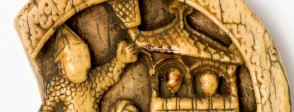Start by gathering ideas about what this object might be and when they think it dates from. More examples of tablemen can be found online through the website of the Victoria and Albert Museum – see For the classroom. Ask the students how they can tell that this is a medieval object. Then gather evidence for their views by, for example, comparing the figure on the counter with Norman soldiers depicted on the Bayeux tapestry - see Object file: the Bayeux tapestry for images. You could compare the silver coin in For the classroom.
Ask your students to analyse whether the castle on the counter is a typical Norman castle. You could use the first page of the BBC Primary History resource in For the classroom. Then ask them to do the same exercise with an actual castle using photos downloaded from the internet or on a visit. Discuss the main features of the castle and the reasons for their design. This can lead onto a discussion about the importance of building castles, possibly using the BBC Class Clip about Dover Castle in For the classroom.
Look at a map of England and Normandy and discuss why William I built his first three castles at Hastings, Pevensey and Dover. Move on to Henry II and consider why he spent more money on Dover Castle than on any other site and why he built the castle at Orford. Sequences of the Time Team video in About the object may be useful for this. Then move on to look at the distribution of Norman castles across England.
Ask groups of students to come up with the pros and cons of building castles from wood and from stone. Discuss the balance between the speed of construction from wood and the strength of stone and in what circumstances one may be preferable to the other.
Apart from their military role, consider what other purposes castles had. Select a small number of castles in differing locations and consider why they were built where they were. Groups of students could take a castle each and develop a case study for presentation or display. Examples might include: Dover (coastal), Lewes (near a monastery), Exeter (in a town), Stokesay (rural – strictly a fortified manor house).
Discuss who might have owned a set of ivory counters like this one. Use the conclusions to look at other aspects of the life of the lords and from there move on to the overall structure of Norman society – see the BBC Bitesize resource in For the classroom. Use the pieces from the Lewis chess set in For the classroom to see how the structure of society was reflected in the hierarchy of pieces in chess.
Ask your students to examine the Norman and Plantagenet family tree in For the classroom. They should work in pairs to decide who should succeed Henry I. After they have made their decision, show them the videos about Stephen and Matilda and then ask them to consider whether their previous answer has changed. They could use their decisions and the information from the videos to create promotional materials or presentations for Stephen or Matilda.
You could use the counter at the end of your study of the political turmoil of the AD 1100s. Discuss the likely owner, look at the details and identify the biblical story it tells. Review what the students have learned about the civil strife in England. Use all these considerations to reflect on what might have occurred to the lord as he played Tables with this piece.
The objects in A bigger picture could be used along with the counter and the Object file: a Roman game board to develop a thematic study of games through time and how they reflect important aspects of the period and society in which they were played.


